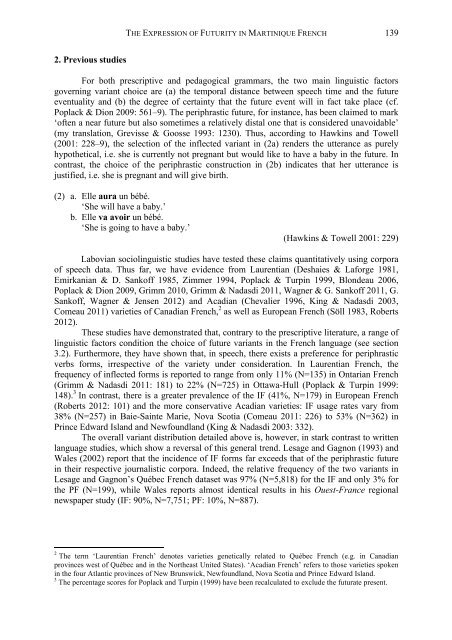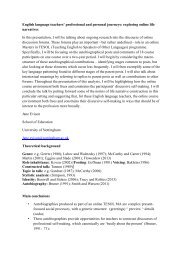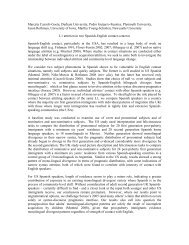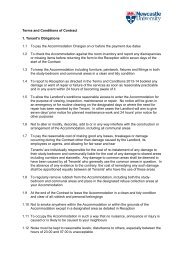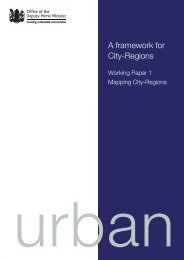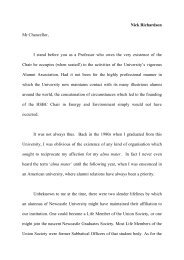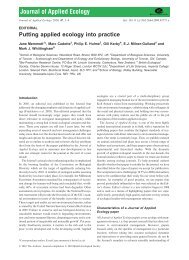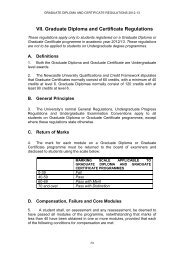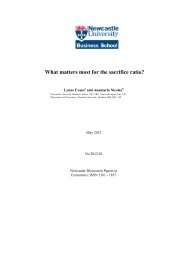the influence of linguistic factors on the expression of futurity
the influence of linguistic factors on the expression of futurity
the influence of linguistic factors on the expression of futurity
You also want an ePaper? Increase the reach of your titles
YUMPU automatically turns print PDFs into web optimized ePapers that Google loves.
THE EXPRESSION OF FUTURITY IN MARTINIQUE FRENCH 139<br />
2. Previous studies<br />
For both prescriptive and pedagogical grammars, <str<strong>on</strong>g>the</str<strong>on</strong>g> two main <str<strong>on</strong>g>linguistic</str<strong>on</strong>g> <str<strong>on</strong>g>factors</str<strong>on</strong>g><br />
governing variant choice are (a) <str<strong>on</strong>g>the</str<strong>on</strong>g> temporal distance between speech time and <str<strong>on</strong>g>the</str<strong>on</strong>g> future<br />
eventuality and (b) <str<strong>on</strong>g>the</str<strong>on</strong>g> degree <str<strong>on</strong>g>of</str<strong>on</strong>g> certainty that <str<strong>on</strong>g>the</str<strong>on</strong>g> future event will in fact take place (cf.<br />
Poplack & Di<strong>on</strong> 2009: 561–9). The periphrastic future, for instance, has been claimed to mark<br />
‘<str<strong>on</strong>g>of</str<strong>on</strong>g>ten a near future but also sometimes a relatively distal <strong>on</strong>e that is c<strong>on</strong>sidered unavoidable’<br />
(my translati<strong>on</strong>, Grevisse & Goosse 1993: 1230). Thus, according to Hawkins and Towell<br />
(2001: 228–9), <str<strong>on</strong>g>the</str<strong>on</strong>g> selecti<strong>on</strong> <str<strong>on</strong>g>of</str<strong>on</strong>g> <str<strong>on</strong>g>the</str<strong>on</strong>g> inflected variant in (2a) renders <str<strong>on</strong>g>the</str<strong>on</strong>g> utterance as purely<br />
hypo<str<strong>on</strong>g>the</str<strong>on</strong>g>tical, i.e. she is currently not pregnant but would like to have a baby in <str<strong>on</strong>g>the</str<strong>on</strong>g> future. In<br />
c<strong>on</strong>trast, <str<strong>on</strong>g>the</str<strong>on</strong>g> choice <str<strong>on</strong>g>of</str<strong>on</strong>g> <str<strong>on</strong>g>the</str<strong>on</strong>g> periphrastic c<strong>on</strong>structi<strong>on</strong> in (2b) indicates that her utterance is<br />
justified, i.e. she is pregnant and will give birth.<br />
(2) a. Elle aura un bébé.<br />
‘She will have a baby.’<br />
b. Elle va avoir un bébé.<br />
‘She is going to have a baby.’<br />
(Hawkins & Towell 2001: 229)<br />
Labovian socio<str<strong>on</strong>g>linguistic</str<strong>on</strong>g> studies have tested <str<strong>on</strong>g>the</str<strong>on</strong>g>se claims quantitatively using corpora<br />
<str<strong>on</strong>g>of</str<strong>on</strong>g> speech data. Thus far, we have evidence from Laurentian (Deshaies & Laforge 1981,<br />
Emirkanian & D. Sank<str<strong>on</strong>g>of</str<strong>on</strong>g>f 1985, Zimmer 1994, Poplack & Turpin 1999, Bl<strong>on</strong>deau 2006,<br />
Poplack & Di<strong>on</strong> 2009, Grimm 2010, Grimm & Nadasdi 2011, Wagner & G. Sank<str<strong>on</strong>g>of</str<strong>on</strong>g>f 2011, G.<br />
Sank<str<strong>on</strong>g>of</str<strong>on</strong>g>f, Wagner & Jensen 2012) and Acadian (Chevalier 1996, King & Nadasdi 2003,<br />
Comeau 2011) varieties <str<strong>on</strong>g>of</str<strong>on</strong>g> Canadian French, 2 as well as European French (Söll 1983, Roberts<br />
2012).<br />
These studies have dem<strong>on</strong>strated that, c<strong>on</strong>trary to <str<strong>on</strong>g>the</str<strong>on</strong>g> prescriptive literature, a range <str<strong>on</strong>g>of</str<strong>on</strong>g><br />
<str<strong>on</strong>g>linguistic</str<strong>on</strong>g> <str<strong>on</strong>g>factors</str<strong>on</strong>g> c<strong>on</strong>diti<strong>on</strong> <str<strong>on</strong>g>the</str<strong>on</strong>g> choice <str<strong>on</strong>g>of</str<strong>on</strong>g> future variants in <str<strong>on</strong>g>the</str<strong>on</strong>g> French language (see secti<strong>on</strong><br />
3.2). Fur<str<strong>on</strong>g>the</str<strong>on</strong>g>rmore, <str<strong>on</strong>g>the</str<strong>on</strong>g>y have shown that, in speech, <str<strong>on</strong>g>the</str<strong>on</strong>g>re exists a preference for periphrastic<br />
verbs forms, irrespective <str<strong>on</strong>g>of</str<strong>on</strong>g> <str<strong>on</strong>g>the</str<strong>on</strong>g> variety under c<strong>on</strong>siderati<strong>on</strong>. In Laurentian French, <str<strong>on</strong>g>the</str<strong>on</strong>g><br />
frequency <str<strong>on</strong>g>of</str<strong>on</strong>g> inflected forms is reported to range from <strong>on</strong>ly 11% (N=135) in Ontarian French<br />
(Grimm & Nadasdi 2011: 181) to 22% (N=725) in Ottawa-Hull (Poplack & Turpin 1999:<br />
148). 3 In c<strong>on</strong>trast, <str<strong>on</strong>g>the</str<strong>on</strong>g>re is a greater prevalence <str<strong>on</strong>g>of</str<strong>on</strong>g> <str<strong>on</strong>g>the</str<strong>on</strong>g> IF (41%, N=179) in European French<br />
(Roberts 2012: 101) and <str<strong>on</strong>g>the</str<strong>on</strong>g> more c<strong>on</strong>servative Acadian varieties: IF usage rates vary from<br />
38% (N=257) in Baie-Sainte Marie, Nova Scotia (Comeau 2011: 226) to 53% (N=362) in<br />
Prince Edward Island and Newfoundland (King & Nadasdi 2003: 332).<br />
The overall variant distributi<strong>on</strong> detailed above is, however, in stark c<strong>on</strong>trast to written<br />
language studies, which show a reversal <str<strong>on</strong>g>of</str<strong>on</strong>g> this general trend. Lesage and Gagn<strong>on</strong> (1993) and<br />
Wales (2002) report that <str<strong>on</strong>g>the</str<strong>on</strong>g> incidence <str<strong>on</strong>g>of</str<strong>on</strong>g> IF forms far exceeds that <str<strong>on</strong>g>of</str<strong>on</strong>g> <str<strong>on</strong>g>the</str<strong>on</strong>g> periphrastic future<br />
in <str<strong>on</strong>g>the</str<strong>on</strong>g>ir respective journalistic corpora. Indeed, <str<strong>on</strong>g>the</str<strong>on</strong>g> relative frequency <str<strong>on</strong>g>of</str<strong>on</strong>g> <str<strong>on</strong>g>the</str<strong>on</strong>g> two variants in<br />
Lesage and Gagn<strong>on</strong>’s Québec French dataset was 97% (N=5,818) for <str<strong>on</strong>g>the</str<strong>on</strong>g> IF and <strong>on</strong>ly 3% for<br />
<str<strong>on</strong>g>the</str<strong>on</strong>g> PF (N=199), while Wales reports almost identical results in his Ouest-France regi<strong>on</strong>al<br />
newspaper study (IF: 90%, N=7,751; PF: 10%, N=887).<br />
2 The term ‘Laurentian French’ denotes varieties genetically related to Québec French (e.g. in Canadian<br />
provinces west <str<strong>on</strong>g>of</str<strong>on</strong>g> Québec and in <str<strong>on</strong>g>the</str<strong>on</strong>g> Nor<str<strong>on</strong>g>the</str<strong>on</strong>g>ast United States). ‘Acadian French’ refers to those varieties spoken<br />
in <str<strong>on</strong>g>the</str<strong>on</strong>g> four Atlantic provinces <str<strong>on</strong>g>of</str<strong>on</strong>g> New Brunswick, Newfoundland, Nova Scotia and Prince Edward Island.<br />
3 The percentage scores for Poplack and Turpin (1999) have been recalculated to exclude <str<strong>on</strong>g>the</str<strong>on</strong>g> futurate present.


